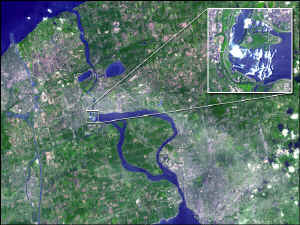Hi
Eastern Native Tree Society friends:
I am pleased to report to you that I finally got the perfect
weather
conditions to go down into the hazardous Niagara Gorge to get
some
accurate readings on the heights of some giant trees down there.
The
exact location is the Niagara Glen, a spectacular 60-acre
Ontario Park
Preserve. I discovered it was entirely old growth forest in
2002. The
Parks Commission, which has owned it since the 1800s, never
realized
this! Tree ages are 200 to 300 years. This area wasn't really
settled
until the War of 1812.
 The Niagara River (a Native American word for “at the neck”), linking Lake Erie and Lake Ontario, flows around Niagara Island, and then plummets over Horseshoe and American Falls, better known as Niagara Falls. The port city of Buffalo, New York is located at the northeast corner of Lake Erie where the river first leaves the lake. The image also includes the infamous Love Canal. In the late 1970s and early 1980s, as a result of chemical wastes having been dumped in the area of the Love Canal from 1947 to 1952, the area was evacuated. In 1990, after a 12-year cleanup effort, the federal government declared parts of the area habitable and reopened those areas.
The Niagara River (a Native American word for “at the neck”), linking Lake Erie and Lake Ontario, flows around Niagara Island, and then plummets over Horseshoe and American Falls, better known as Niagara Falls. The port city of Buffalo, New York is located at the northeast corner of Lake Erie where the river first leaves the lake. The image also includes the infamous Love Canal. In the late 1970s and early 1980s, as a result of chemical wastes having been dumped in the area of the Love Canal from 1947 to 1952, the area was evacuated. In 1990, after a 12-year cleanup effort, the federal government declared parts of the area habitable and reopened those areas.
The results are really exciting. I used a clinometer and laser
range
finder, with multiple readings from many vantage points:
1) "The Niagara
Giant", a Tulip Tree = 134.1 feet tall (10'0"
DBH, 230 years old)
This
is appears to be the tallest hardwood (broadleaf) tree
in Ontario ! This is not a minor statement, since this province
is
larger than Texas and California combined. The Niagara Ontario
Parks
Commission is very excited about this. Previously, I measured it
when
the leaves were on, and got widely varying readings from 124 to
135
feet, so I knew I had to do it when the leaves were off. But ice
came
early to the gorge, preventing from me from getting down there
in
autumn. Now it is confirmed.
2) "The Sassafras Sage" - 82.1 feet
tall (175 years old)
Considering
this is the extreme northern edge of Sassafras'
range, this is a remarkable height. It is also the Canadian
National
Champion Sassafras, quite notable. Americans always overlook
that Canada
also has lots of big trees. "American" Forests'
National Register of Big
Trees ignores Canada entirely. This is a shameful attitude,
since trees'
ranges, ecologies and problems do not conform to national
boundaries.
3) The Chinkapin
Champ, a Chinkapin Oak = 101 feet tall (9'5"
DBH, ~260 years old). This makes it the new Champion for this
species
according to the ENTS list, replacing the 67.8 foot tall
specimen from
Tennessee.
However, the National Register of Big Trees lists a Chinkapin
Oak at 110
feet tall. I know ENTS considers the American Forests tree as
not
"accurately measured," and therefore not reliable or
valid. So the big
question, which should be considered the champion for tall tree?
Niagara Glen also contains a forest community which I have never
encountered before. If anybody has encountered this or if it is
a
totally new type of forest community, I would appreciate some
feedback.
It is an Old Growth Chinkapin Oak-Hop Hornbeam-Sugar
Maple-Northern
White Cedar Forest. The Hop Hornbeams are all old growth and
co-dominant, which is remarkable in itself. They are up to 15
inch
diameter, and over 300 years old. The cedars are up to 600 years
old.
Any professor or forester who tells you that hop hornbeam
("ironwood")
is short-lived and ensures that a site is an early successional
forest
has no experience with "real untrammeled nature."
Here is more background on Niagara Gorge. It is a 300-foot deep,
7-mile
canyon carved by Niagara Falls. It is a spectacular place,
including the
Whirlpool Rapids, 4 miles downstream from the Falls. They are
the
largest "standing waves" in North America, 22 feet
tall, all the time,
in one place. Despite the fact that 100s of scientists have
studied the
gorge over the last 2 centuries, it never occurred to any of
them that
it is filled with ancient trees. I discovered them in 1999.
There are
1300 ancient northern white cedars along the cliffs and talus
slopes,
300 to probably over 600 years old, possibly 750 years old.
There are
cedar groves of 500-year old trees. Separate from these is the
60-acre
Niagara Glen which is where the old growth forests and the
champion
tulip trees, etc. are located. I discovered this (as old growth)
in
2001. The Glen is a perched terrace inside the gorge, beneath
cliffs
from above, but overlooking the 15 feet tall Devils Hole Rapids
of the
Niagara River. The Glen is filled with giant boulders strewn
everywhere,
caves, and dozens of rare ferns and wildflowers.
If any of you come out here to Western New York, let me know and
I will
give you a tour of the fabulous Zoar Valley Gallery of Giants!
Bruce
|